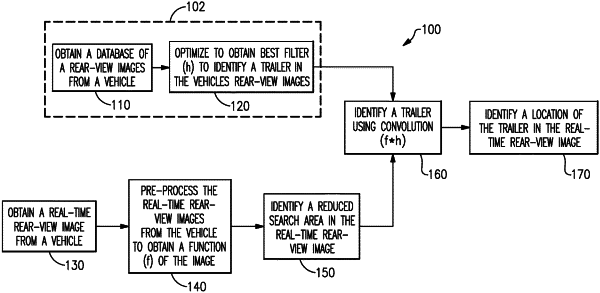| CPC G06T 7/74 (2017.01) [G06V 10/443 (2022.01); G06V 20/56 (2022.01); G06T 2207/30252 (2013.01)] | 20 Claims |

|
1. A method for determining a location of a trailer in an image, the method comprising:
obtaining, from a camera by a controller comprising at least one microprocessor, at least one real-time image from a vehicle;
processing, by the at least one microprocessor, the at least one real-time image to obtain a feature patch describing at least one real-time image;
performing, by the at least one microprocessor, a convolution of the feature patch and each filter from a set of filters with the set of filters being based on data representative of known trailers;
determining, by the at least one microprocessor, a location of a trailer in the at least one real-time image based on the convolution between the feature patch and each filter from the set of filters; and
at least one of sending, by the at least one microprocessor, and determined trailer location to a vehicle display for displaying the determined location of the trailer, or using, by the at least one microprocessor, the determined location of the trailer in a trailer assist operation,
wherein determining the location of the trailer includes utilizing an algorithm on the controller executed by the at least one microprocessor that identifies a location of highest probability of the location of the trailer, and
wherein the at least one real time image includes consecutive real-time images and the method further includes reducing, by the at least one microprocessor, a search area of the consecutive real-time images including comparing the consecutive real-time images to identify areas with objects that did not move between the consecutive images and searching the areas with objects that did not move when the vehicle is moving and the connected trailer is in alignment with the vehicle.
|